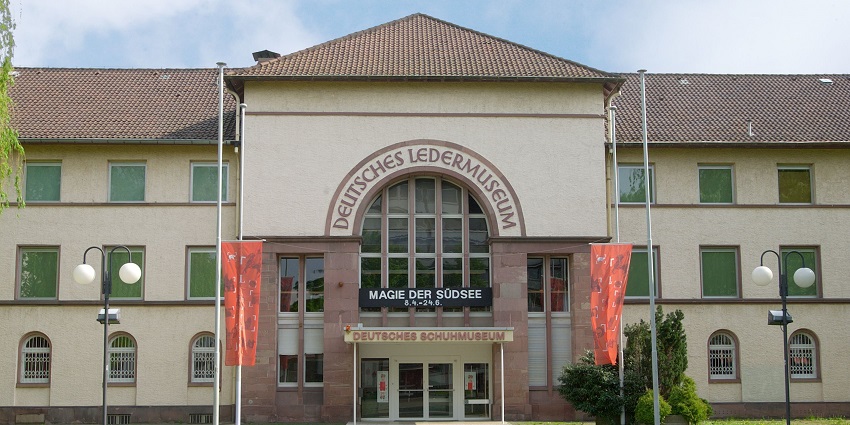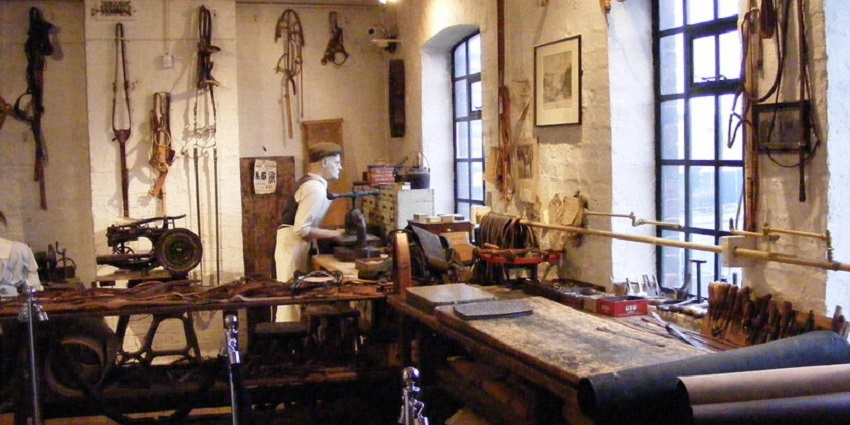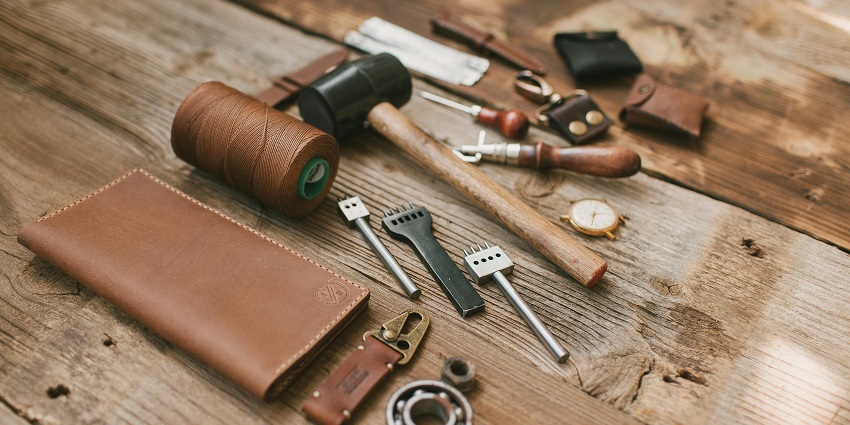Leather museums offer a unique opportunity to explore leather’s rich history and craftsmanship. These museums focus on the material’s evolution, showcasing its use across different cultures and periods. Visitors can discover the various processes involved in leather production, from traditional techniques to modern advancements. The exhibits often feature a wide range of leather items, including tools, garments, and accessories, reflecting the material’s versatility and significance. Leather museums highlight its cultural importance and role in the fashion, art, and design industries. These museums provide valuable insight into a craft that has shaped societies for centuries.
Top 10 Leather Museums In The World
Here is a list of some of the best leather museums in the world, each celebrating the art, craft, and history of leather production.
1. German Leather Museum / Deutsches Ledermuseum

Photo: Stadt Offenbach am Main / Wikimedia Commons
The German Leather Museum showcases a vast collection of over 30,000 objects representing the history of leather in art, fashion, and industry. The museum highlights leather’s cultural impact through various exhibits, including historical tools, garments, and accessories. Visitors to this museum can explore the entire leather production process, from raw hides to finished products, and gain insight into the technological advancements in leatherworking. It is one of the best leather museums in the world and also offers special exhibitions and educational programmes on leather craftsmanship.
Location: Offenbach am Main, Hesse, Germany
Timings: 10 AM – 5 PM
Entry Fee: Free
2. Walsall Leather Museum

Photo: Skvader / Wikimedia Commons / Image For Representation Only
The Walsall Leather Museum focuses on the town’s historical significance in saddlery, with unique displays of the leather goods that made Walsall famous worldwide. Visitors can view the tools and machinery used by local leatherworkers over the centuries. The museum highlights Walsall’s significant contribution to the British Army, particularly supplying military saddles. There are special exhibitions in this museum that focus on this unique aspect of the town’s leather industry. This famous leather museum also features workshops where visitors can try creating leather items using traditional saddlery and upholstery methods.
Location: 34-36 Lichfield Street, Walsall, WS1 2AR, West Midlands, England
Timings: 10 AM – 4 PM
Entry Fee: Free
3. Museum Of Leather Artistry

Photo: Peggy_Marco / Pixabay / Image For Representation Only
The Museum of Leather Artistry is a popular leather museum known for its impressive collection. Andreu Colomer I Munmany, a skilled tanner from Vic, primarily gathered the museum’s collection. The museum is housed in the former Convent of El Carme, offering a unique blend of history and craftsmanship. It showcases leather items from various periods, including decorative trunks, altar frontals, and saddles, giving visitors insight into how leather evolved from practical use to intricate art forms. One of its highlights is the guadamassil technique, which uses polychrome or gold-embossed leather.
Location: Carrer de l’Arquebisbe Alemany, 5, 08500 Vic, Barcelona, Spain
Timings: 10 AM – 1 PM ; 4 PM – 7 PM
Entry Fee: Free
4. Igualada Leather Museum / Museu De La Pell D’Igualada

Photo: Joan Grifols / Wikimedia Commons
The Igualada Leather Museum is considered one of the best leather museums in the world, offering a unique insight into the region’s deep connection with leather production. The museum is in an old leather tannery and focuses on the history of tanning in Igualada, a town renowned for its leather industry. One of the key aspects of the museum is its exploration of how the leather trade played a significant role in shaping the local economy. The museum also addresses the environmental impacts of tanning, educating visitors on modern sustainable practises.
Location: Carrer del Dr. Joan Mercader, 1, 08700 Igualada, Barcelona, Spain
Timings: 10 AM – 2 PM; 4 PM – 8 PM; Sunday, 10 AM – 2 PM
Entry Fee: €3.80 (₹ 354.03)
5. Leather And Shoe Museum / Leder En Schoenen Museum

Photo: HARTLEPOOLMARINA2014 / Wikimedia Commons / Image For Representation Only
Leather and Shoe Museum is a well-known institution preserving the heritage of leather craftsmanship and footwear design. This museum is housed in a landmark building designed by architect Alexander Kropholler, blending traditional craftsmanship with modern elements. The collection features a vast range of historical and contemporary shoes, leather goods, and tools, reflecting the region’s deep connection to the leather industry. It also serves as a knowledge centre, offering workshops, research facilities, and interactive exhibits.
Location: Waalwijk, Netherlands
Timings: 10 AM – 5 PM
Entry Fee: No entry fee (voluntary donation is available)
6. Ubrique Leather Museum

Photo: El Pantera / Wikimedia Commons
The Ubrique Leather Museum preserves the region’s long tradition of leather craftsmanship. It is housed in a historic 17th-century Baroque monastery, showcasing the history of local artisans who gained international recognition for their leatherwork. The museum’s exhibition, “Hands and Magic in Leather,” displays traditional tools, handcrafted goods, and historic machinery. Visitors can explore how skilled craftsmen shaped the leather industry, from early hand-stitching techniques to modern production methods.
Location: Av. Herrera Oria, 10, 11600 Ubrique, Cádiz, Spain
Timings: 10 AM – 2 PM; 4 PM – 6 PM
Entry Fee: €2.50 (₹232.69)
7. Museum Of Leathercraft / National Leather Collection

Photo: Gordon Griffiths / Wikimedia Commons / Image For Representation Only
The Museum of Leathercraft, also known as the National Leather Collection, preserves the history and craftsmanship of leather. It was originally established to document the evolution of leatherworking and has relocated to Northampton due to the town’s strong shoemaking and leather manufacturing heritage. It holds an extensive collection, including rare historical pieces such as fragments of the Dead Sea Scrolls and pages from a centuries-old Qur’an. The museum provides insight into leather’s cultural and industrial significance, displaying items that highlight both traditional techniques and artistic applications.
Location: Grosvenor Chambers, Grosvenor Shopping Centre, Northampton, England
Timings: 10 AM – 4 PM
Entry Fee: Free
8. Leather Museum In Bort-Les-Orgues / Musée De La Tannerie Et Du Cuir

Photo: Found5dollar / Wikimedia Commons / Image For Representation Only
The Leather Museum in Bort-les-Orgues preserves the town’s long history of leather production. The region was once a centre for tanning, with local craftsmen using traditional methods to process hides. The museum is housed in a former tannery, reflecting the industry’s deep roots in the area. It traces the evolution of leatherworking from early manual techniques to later innovations that shaped local and regional trade. The museum also sheds light on historical challenges tanners face, including environmental concerns and changing production methods over time.
Location: Bort-les-Orgues, Corrèze, France
Timings: 9 AM – 12 PM, 2 PM – 5 PM
Entry Fee: €6.50 (₹605.12)
9. Museum Of Leather And Furriery

Photo: Vlada Karpovich / Pexels / Image For Representation Only
The Museum of Leather and Furriery presents the history of leather and fur craftsmanship, highlighting the techniques used by artisans to transform animal hides into durable leather and fine fur products. Exhibits include traditional tanning tools, historic leather goods, and fur garments that once played a key role in trade. The museum traces the development of leather and fur production methods over time, showing their economic significance and impact on local industries. Through its collection, the museum provides insight into the artistry of leatherworking and the challenges of preserving these industries today.
Location: Laval, France
Timings: 10 AM – 6 PM
Entry Fee: €5.00 (₹465.84)
10. Museum Of Leather And Saddlery

Photo: cottonbro studio / Pexels / Image For Representation Only
The Museum of Leather and Saddlery focuses on the craft of leatherworking, with a special emphasis on saddlery. It showcases the role of leather in producing saddles, harnesses, and other equestrian equipment. The exhibits include handcrafted saddles from different time periods, demonstrating how designs evolved to improve comfort and functionality. Visitors can see the tools used by saddlers and learn about traditional techniques for cutting, shaping, and stitching leather. The museum also explores the connection between the leather industry and horse-riding culture, showing its impact on transportation and trade.
Location: Châteauneuf-sur-Sarthe, France
Timings: 9:30 AM – 5:30 PM
Entry Fee: €4.50 (₹419.26)
Leather museums offer a fascinating exploration of the craftsmanship and history behind leather production. These museums showcase leather’s importance in art, fashion, and industry from traditional methods to modern advancements. For anyone interested in understanding the cultural and historical significance of leather, these museums provide a unique and educational experience. Book your trip with TripXL and delve into the world of leather craftsmanship.
Cover Photo: Deutsches Ledermuseum / Wikimedia Commons


 WhatsApp
WhatsApp
 Twitter
Twitter









